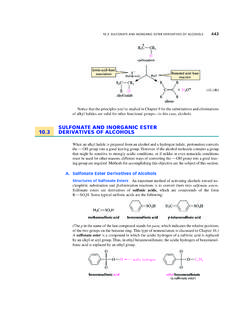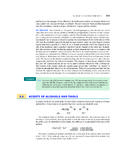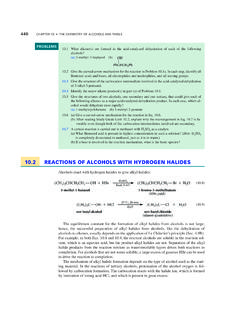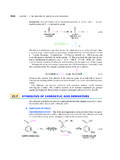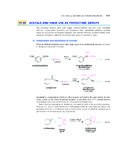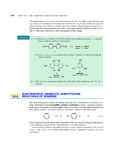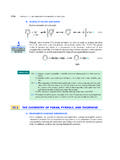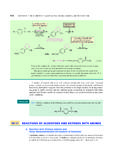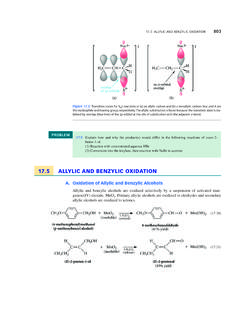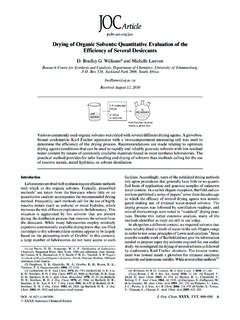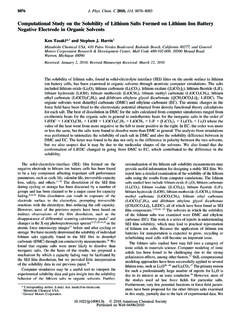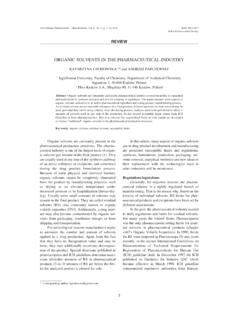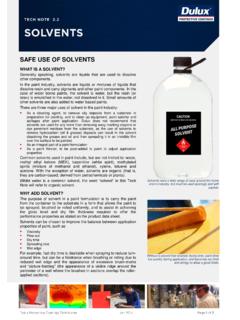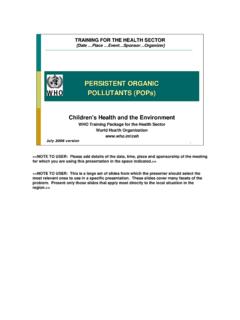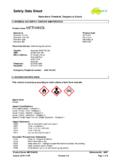Transcription of 8.4 SOLVENTS IN ORGANIC CHEMISTRY - Sapling …
1 SOLVENTS IN ORGANIC Label each of the following molecules as a hydrogen-bond acceptor, donor, or both. Indicatethe hydrogen that is donated or the atom that serves as the hydrogen-bond acceptor.(a)(b) (c)(d) (e)(f ) H3 CLCH2L| IN ORGANIC CHEMISTRYA solventis a liquid used to dissolve a compound. SOLVENTS have tremendous practical impor-tance. They affect the acidities and basicities of solutes. In some cases, the choice of a solventcan have dramatic effects on reaction rates and even on the outcome of a reaction. Understand-ing effects like these requires a classification of solvent types, to which Section is rational choice of a solvent requires an understanding of solubility that is, how wella given compound dissolves in a particular solvent. Section discusses the principles thatwill allow you to make general predictions about the solubilities of both covalent ORGANIC com-pounds and ions in different SOLVENTS .
2 The effects of SOLVENTS on chemical reactions are closelytied to the principles of solubility. Solubility is also important in biology. For example, the solubilities of drugs determine theforms in which they are marketed and used, and such important characteristics as whether theyare absorbed from the gut and whether they pass from the bloodstream into the brain. Some ofthese ideas are explored in Section certain alcohols, alkyl halides, and ethers are among the most important organicsolvents, this is a good point our survey of ORGANIC CHEMISTRY to study solvent Classification of SolventsThere are three broad solvent categories, and they are not mutually exclusive; that is, a solventcan be in more than one A solvent can be proticor A solvent can be polaror A solvent can be a donoror a protic solventconsists of molecules that can act as hydrogen-bond donors.
3 Water,alcohols, and carboxylic acids are examples of protic SOLVENTS . SOLVENTS that cannot act as hy-drogen-bond donors are called aprotic , methylene chloride, and hexane areexamples of aprotic polar solventhas a high dielectric constant; an apolar solventhas a low dielectric con-stant. The dielectric constantis defined by the electrostatic law,which gives the interaction en-ergy Ebetween two ions with respective charges q1and q2separated by a distance r:E=k( )In this equation, kis a proportionality constant and eis the dielectric constant of the solvent inwhich the two ions are imbedded. This equation shows that when the dielectric constant eislarge, the magnitude of E, the energy of interaction between the ions, is small. This means thatq1q2! 12/8/08 11:05 AM Page 339340 CHAPTER 8 INTRODUCTION TO ALKYL HALIDES, ALCOHOLS, ETHERS, THIOLS, AND SULFIDES both attractions between ions of opposite charge and repulsions between ions of like chargeare weak in a polar solvent.
4 Thus, a polar solvent effectively separates, or shields, ions fromone another. This means, in turn, that the tendency of oppositely charged ions to associate isless in a polar solvent than it is in an apolar solvent. If a solvent has a dielectric constant ofabout 15 or greater, it is considered to be polar. Water (e=78), methanol (e=33), and formicacid (e=59) are polar SOLVENTS . Hexane (e=2), ether (e=4), and acetic acid (e=6) are ap-olar , the word polarhas a double usage in ORGANIC CHEMISTRY . When we say thata moleculeis polar, we mean that it has a significant dipole moment, m(Sec. ). When wesay that a solventis polar, we mean that it has a high dielectric constant. In other words, sol-vent polarity, or dielectric constant, is a property of many molecules acting together, but mol-ecular polarity, or dipole moment, is a property of individual molecules.
5 Although it is truethat all polar solventsconsist of polar molecules,the converse is not true. The contrast be-tween acetic acid and formic acid is particularly striking:These two compounds contain identical functional groups and have very similar structuresand dipole moments. Both are polar molecules. Yet they differ substantially in their dielectricconstants and in their solvent properties! Formic acid is a polar solvent; acetic acid is solventsconsist of molecules that can donate unshared electron pairs that is, mol-ecules that can act as Lewis bases. Ether, THF, and methanol are donor SOLVENTS . Nondonorsolventscannot act as Lewis bases; pentane and benzene are nondonor b l e 8 . 2 o n p . 3 4 1 l i s t s s o m e c o m m o n s o l ve n t s u s e d i n o rg a n i c c h e m i s t r y a l o n g w i t h t h e i rabbreviations and their classifications.
6 This table shows that a solvent can have a combinationof properties, as noted at the beginning of this section. For example, some polar SOLVENTS areprotic (such as water and methanol), but others are aprotic (such as acetone). Classify each of the following substances according to their solvent properties (as inTa b l e 8 . 2 ) .(a)2-methoxyethanol (e=17)(b) 2,2,2-trifluoroethanol (e=26)(c)(d) 2,2,4-trimethylpentane (e=2)B. SolubilityOne role of a solvent is simply to dissolve compounds of interest. Although finding a suitablesolvent can involve some trial and error, certain principles can help us choose a solvent ratio-nally. The discussion of solubility is divided into two parts: the solubility of covalent com-pounds, and the solubility of ionic of Covalent CompoundsIn determining a solvent for a covalent compound, auseful rule of thumb is like dissolves like.
7 That is, a good solvent usually has some of the mol-ecular characteristics of the compound to be dissolved. For example, an apolar aprotic solventis likely to be a good solvent for another apolar aprotic substance. In contrast, a protic solventLCLCH2CH3 (e = 19)H3 CSOLCLOHH3 CSOacetic acidm = De = acidm = De = 12/8/08 11:05 AM Page SOLVENTS IN ORGANIC CHEMISTRY341 Properties of Some Common ORGANIC SOLVENTS (Listed in order of increasing dielectric constant)CommonBoilingDielectricClassSol ventStructure abbrevationpoint, Cconstant e*PolarProticDonorhexaneCH3(CH2)4CH3 ,4-dioxane ether(C2H5) chlorideCH2Cl2 ' 287 (dec)43xxdimethylsulfoxideDMSO18947xxfor mic acid 211 (dec)111xxx*Most values are at or near 25 C Known carcinogenHCNH2 OSHCOHOSCH3 SCH3 OSSOO@@HCN(CH3)2 OSN,N-dimethylformamideNCH3 OCH3 CCH3 OSOCH3 COHOSCH3 COC2H5 OSOOTABLE 12/8/08 11.
8 05 AM Page 341342 CHAPTER 8 INTRODUCTION TO ALKYL HALIDES, ALCOHOLS, ETHERS, THIOLS, AND SULFIDESin which significant hydrogen-bonding interactions occur between molecules is likely to dis-solve another protic substance in which hydrogen bonding between molecules is also an impor-tant cohesive i l l u s t r a t e , l e t s c o n s i d e r t h e wa t e r s o l u b i l i t y o f o rg a n i c c o m p o u n d s . T h i s i s a n i m p o r t a n tissue in biology, because water is the solvent in living systems. Consider the water solubilityof the following compounds of comparable size and molecular mass:Of these compounds, the alcohol, 1-propanol, is most soluble; in fact, it is misciblewithwater. This means that a solution is obtained when the alcohol is mixed with water in any pro-portion.
9 Of the compounds shown, the alcohol is also most like water because it is protic. Theability both to donate a hydrogen bond to water and to accept a hydrogen bond from water isan important factor in water solubility. The ether contains an atom (oxygen) that can accept hydrogen bonds from water, although itcannot donate a hydrogen bond; hence, it has some water-like characteristics, but is less likewater than the alcohol. Finally, the alkane (butane) and the alkyl halide (ethyl chloride) can neither donate nor accepthydrogen bonds and are therefore least like water; they are also the least water-soluble com-pounds on the same effect occurs in the following series:Alcohols with long hydrocarbon chains that is, large alkyl groups are more like alkanesthan are alcohols containing small alkyl groups.
10 Because alkanes cannot form hydrogenbonds, they are insoluble in water, but they are soluble in other apolar aprotic SOLVENTS ,including other alkanes. Hence, alcohols (as well as any other ORGANIC compounds) with longhydrocarbon chains are relatively insoluble in water and are more soluble in apolar aprotic sol-vents than alcohols with small alkyl consisting of polar molecules lie between the extremes of water on the one handand hydrocarbons on the other. For example, consider the widely used solvent tetrahydrofuranCH3CH2CH2 OHCH3 OHCH3CH2 OHwater mass % mass %an ether can accept hydrogen bonds from alcohol can donate ahydrogen bond to wateran alcohol can accepthydrogen bonds from solubility:CH3CH2CH2CH3CH3CH2 Clvirtually insolubleLCH3CH2 OLCH3solubleLCH3CH2CH2 OHmiscibleSTUDY GUIDE LINK Points andSolubilitiesFurther Exploration of CovalentCompounds:A Deeper 12/8/08 11:05 AM Page SOLVENTS IN ORGANIC CHEMISTRY343(THF; see Table ).
